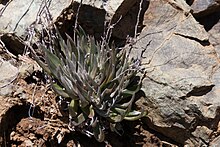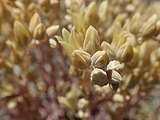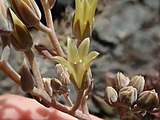Dudleya abramsii subsp. setchellii
| Dudleya abramsii subsp. setchellii | |
|---|---|

| |
| Scientific classification | |
| Kingdom: | Plantae |
| Clade: | Tracheophytes |
| Clade: | Angiosperms |
| Clade: | Eudicots |
| Order: | Saxifragales |
| Family: | Crassulaceae |
| Genus: | Dudleya |
| Species: | |
| Subspecies: | D. a. subsp. setchellii
|
| Trinomial name | |
| Dudleya abramsii subsp. setchellii | |
| Synonyms | |
| |
Dudleya abramsii subsp. setchellii, known by the common name Dudleya setchellii, the Santa Clara Valley dudleya, or Santa Clara Valley liveforever, is a member of the Dudleya genus of succulent perennials, members of the family Crassulaceae. The Santa Clara Valley dudleya, endemic to the Santa Clara Valley region in the southern San Francisco Bay Area, was listed on February 3, 1995, as an endangered species.[1] It is considered to be a subspecies of Dudleya abramsii, but its taxonomic status is still unclear. Its closest relative is Dudleya cymosa subsp. paniculata, which is a morphologically similar sister taxon.[2][3][4]
Description[]
Morphology[]
D. abramsii subsp. setchellii bears few rosettes, which are roughly 2 to 9 cm wide. The caudex is 10 to 20 mm thick. Leaves are glaucous and 3 to 8 cm long, 7 to 15 mm wide, with leaf morphology ranging from oblong-triangular to lance-elliptic to lanceolate.[5]
On the inflorescence, the peduncle is 5 to 20 cm long and 2 to 4 mm wide, with the lower bracts being 10 to 25 mm long. At the top of the inflorescence, it is split into 2 to 3 branches. Pedicels are 2 to 7 mm long.[5]
The flower has deltate sepals, 2 to 5 mm long. The petals are 8 to 13 mm long, 2.5 to 3 mm wide, elliptic, and pale yellow.[5]
D. a. subsp. setchellii blooms from May to June.[5]
Taxonomy[]
| Cladogram of Dudleya setchellii | |||||||||||||||
|
Dudleya abramsii subsp. setchellii has undergone numerous changes in its taxonomic classification. Originally placed a subspecies of Cotyledon laxa / Echeveria laxa,[6][7] an antiquated synonym for Dudleya caespitosa, botanists Nathaniel Lord Britton and Joseph Nelson Rose placed it as a separate species within Dudleya in 1903.[8] In a 1957 issue of Madroño, botanist Reid Moran revised setchellii as a subspecies of Dudleya cymosa.[9] Cotyledon caespitosa var. paniculata, now Dudleya cymosa subsp. paniculata, was merged into setchellii.[10] Almost half a century later, Moran and other botanists returned to setchellii, and again revised it as a subspecies of Dudleya abramsii.[3]
It is visually similar to and sometimes indistinguishable from Dudleya cymosa subsp. paniculata.[10] Recent phylogenetic analysis may in fact place setchellii back into a subspecies of D. cymosa, as it is most closely related to D. c. subsp. paniculata.[4] Some argue that it owes a superficial resemblance to Dudleya abramsii subsp. murina.[3]

Distribution[]
Dudleya abramsii subsp. setchellii is found only in the Coyote Valley area of southern Santa Clara County, California, mostly on rocky outcrops within serpentine grasslands on Tulare Hill and the Santa Teresa Hills west of Coyote Creek in south San Jose and south of Metcalf Canyon east of Coyote Creek.[1][3][5]
Gallery[]

Detail of the flowers and inflorescence in bloom

Detail of the flowers and inflorescence in bloom

Detail of the flowers and inflorescence in bloom

Growing in habitat

Plants in habitat
See also[]
References[]
- ^ a b "Dudleya abramsii ssp. setchellii". Calflora. Berkeley, California: The Calflora Database. 2021. Archived from the original on 2021-04-17. Retrieved 23 August 2021.
- ^ The Plant List, retrieved 9 July 2016
- ^ a b c d Moran, Reid (2007). "Dudleya abramsii Rose subsp. setchellii (Jeps.) Moran, comb. nov". Journal of the Botanical Research Institute of Texas. 1 (2): 1015 – via https://brit.org/research/brit-press/journal-of-the-botanical-research-institute-of-texas/.
{{cite journal}}: External link in|via= - ^ a b Yost, J. M.; Bontrager, M.; McCabe, S. W.; Burton, D.; Simpson, M. G.; Kay, K. M.; Ritter, M. (2013). "Phylogenetic relationships and evolution in Dudleya (Crassulaceae)" (PDF). Systematic Botany. 38 (4): 1096–1104. doi:10.1600/036364413X674760. S2CID 15715233.
- ^ a b c d e McCabe, Stephen Ward (2012). "Dudleya abramsii subsp. setchellii". Jepson eFlora. Jepson Flora Project (eds.). Archived from the original on 2016-08-30. Retrieved 23 August 2021.
- ^ Jepson, Willis Linn (1901). "Cotyledon laxa var. setchellii". Flora of Western Middle California: 267 – via crassulaceae.com.
- ^ Jepson, Willis Linn (1936). "Echeveria laxa var. setchellii". Flora of California. 2: 114.
- ^ Britton, Nathaniel Lord; Rose, Joseph Nelson (1903). "Dudleya setchellii". Bulletin of the New York Botanical Garden. 3 (9): 15.
- ^ Moran, Reid (1957). "Dudleya cymosa ssp. setchellii". Madroño. 14 (3): 108.
- ^ a b Nakai, K. M. (1987). "SOME NEW AND RECONSIDERED CALIFORNIA DUDLEYA (CRASSULACEAE)". Madroño. 34 (4): 338.
External links[]
- Jepson Manual Treatment - Dudleya setchellii
- USDA Plants Profile: Dudleya setchellii
- Dudleya setchellii - Photo gallery
- Dudleya
- Endemic flora of California
- Natural history of the California chaparral and woodlands
- Natural history of Santa Clara County, California
- Taxa named by Willis Linn Jepson
- Endemic flora of the San Francisco Bay Area
- Taxa named by Reid Venable Moran
- Crassulaceae stubs





